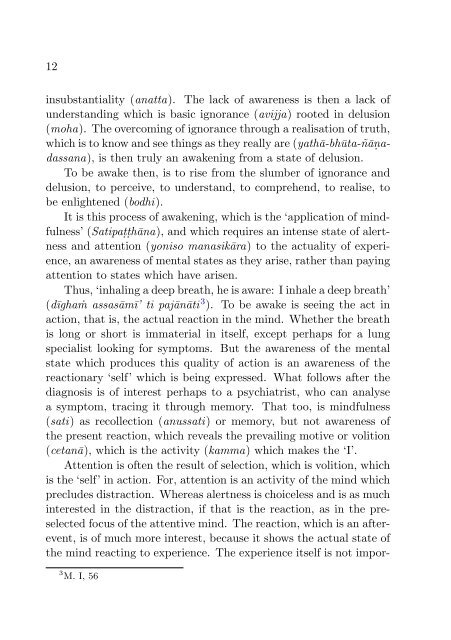Awareness in Buddhist Meditation
A detailed description of awareness in Buddhist Meditation.
A detailed description of awareness in Buddhist Meditation.
Create successful ePaper yourself
Turn your PDF publications into a flip-book with our unique Google optimized e-Paper software.
12<br />
<strong>in</strong>substantiality (anatta). The lack of awareness is then a lack of<br />
understand<strong>in</strong>g which is basic ignorance (avijja) rooted <strong>in</strong> delusion<br />
(moha). The overcom<strong>in</strong>g of ignorance through a realisation of truth,<br />
which is to know and see th<strong>in</strong>gs as they really are (yathā-bhūta-ñāṇadassana),<br />
is then truly an awaken<strong>in</strong>g from a state of delusion.<br />
To be awake then, is to rise from the slumber of ignorance and<br />
delusion, to perceive, to understand, to comprehend, to realise, to<br />
be enlightened (bodhi).<br />
It is this process of awaken<strong>in</strong>g, which is the ‘application of m<strong>in</strong>dfulness’<br />
(Satipaṭṭhāna), and which requires an <strong>in</strong>tense state of alertness<br />
and attention (yoniso manasikāra) to the actuality of experience,<br />
an awareness of mental states as they arise, rather than pay<strong>in</strong>g<br />
attention to states which have arisen.<br />
Thus, ‘<strong>in</strong>hal<strong>in</strong>g a deep breath, he is aware: I <strong>in</strong>hale a deep breath’<br />
(dīghaṁ assasāmī’ ti pajānāti 3 ). To be awake is see<strong>in</strong>g the act <strong>in</strong><br />
action, that is, the actual reaction <strong>in</strong> the m<strong>in</strong>d. Whether the breath<br />
is long or short is immaterial <strong>in</strong> itself, except perhaps for a lung<br />
specialist look<strong>in</strong>g for symptoms. But the awareness of the mental<br />
state which produces this quality of action is an awareness of the<br />
reactionary ‘self’ which is be<strong>in</strong>g expressed. What follows after the<br />
diagnosis is of <strong>in</strong>terest perhaps to a psychiatrist, who can analyse<br />
a symptom, trac<strong>in</strong>g it through memory. That too, is m<strong>in</strong>dfulness<br />
(sati) as recollection (anussati) or memory, but not awareness of<br />
the present reaction, which reveals the prevail<strong>in</strong>g motive or volition<br />
(cetanā), which is the activity (kamma) which makes the ‘I’.<br />
Attention is often the result of selection, which is volition, which<br />
is the ‘self’ <strong>in</strong> action. For, attention is an activity of the m<strong>in</strong>d which<br />
precludes distraction. Whereas alertness is choiceless and is as much<br />
<strong>in</strong>terested <strong>in</strong> the distraction, if that is the reaction, as <strong>in</strong> the preselected<br />
focus of the attentive m<strong>in</strong>d. The reaction, which is an afterevent,<br />
is of much more <strong>in</strong>terest, because it shows the actual state of<br />
the m<strong>in</strong>d react<strong>in</strong>g to experience. The experience itself is not impor-<br />
3 M. I, 56

















